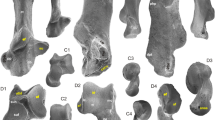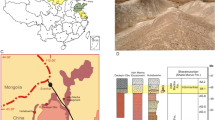Abstract
Diverse metatherian and eutherian tarsal remains from the Late Cretaceous (middle-late Turonian) Bissekty Formation, Kyzylkum Desert, Uzbekistan (ca 90 MYA) are described. Their functional and taxonomic properties, along with those of other tarsal evidence, led to a reassessment of polarity hypotheses of therian, metatherian, and eutherian cruropedal attributes, and the consequences of this for phylogeny of taxa. There are calcaneal remains of several types of marsupials, and a single astragalus that probably belongs to one of these. This represents greater taxonomic diversity than the dental record suggests. Exceptionally large and distally extending peroneal processes, and small and steeply angled calcaneocuboid articulations facing mediodistally, as seen in the Early Cretaceous Sinodelphys and other Cretaceous and Paleogene taxa, attest not only to the metatherian status of these specimens, but also to the retention of many ancestral therian features, even more so than in both the Tiupampa and Itaboraí marsupials of the South American Paleocene (both the calcanea and the astragalus suggest therian traits that are decidedly unlike those of symmetrodonts). Calcanea allocated to the deltatherioid species at Bissekty testify unequivocally to their metatherian affinity. The morphology of the best represented sample of eutherian calcanea from Bissekty, presumably of a number of zhelestid species, appears to be more derived than that of the Late Cretaceous/Paleocene Protungulatum in having a much more reduced peroneal process and a calcaneocuboid articulation that faces distally, oriented nearly at a 90° angle to the long axis of the calcaneus. In fact, this distally facing facet, common in later eutherians (except for lineages in the Paleogene record, and various Carnivora), may not be diagnostic of either the protoeutherian, or even of the protoplacentalian, in spite of its presence in Eomaia. Many putatively “basal” lineages have derived characters, hence such outgroups should not be considered the unequivocal repositories of only ancestral character states.

















Similar content being viewed by others
Abbreviations
- URBAC:
-
Uzbek/Russian/British/American/Canadian Joint Paleontological Expedition specimens currently at San Diego State University, San Diego
- ZIN:
-
Zoological Institute, Russian Academy of Sciences, Saint Petersburg
Literature cited
Archibald JD, Averianov AO (2003) The Late Cretaceous eutherian mammal Kulbeckia. J Vertebr Paleontol 23:404–419
Archibald JD, Averianov AO (2005) Mammalian faunal succession in the Cretaceous of the Kyzylkum Desert. J Mamm Evol 12:9–22
Archibald JD, Averianov AO, Ekdale EG (2001) Late Cretaceous relatives of rabbits, rodents, and other extant eutherian mammals. Nature 414:62–65
Asher RJ (2005) Insectivoran-grade placentals. In: Rose KD, Archibald JD (eds) The rise of placental mammals: Origins and relationships of the major extant clades. The John Hopkins University Press, Baltimore and London, pp 50–70
Asher RJ, Novacek MJ, Geisler JH (2003) Relationships of endemic African mammals and their fossil relatives based on morphological and molecular evidence. J Mamm Evol 10:131–194
Averianov AO, Archibald JD (2003) Mammals from the Upper Cretaceous Aitym Formation, Kyzylkum Desert, Uzbekistan. Creteceous Res 24:171–191
Bergqvist LP (1996) Reassociação do pós-crânio às espécies de ungulados da bacia de S. J. de Itaboraí (Paleoceno), estado do Rio de Janeiro, e filogenia dos “Condylarthra” e ungulados Sul-Americanos com base no pós-crânio. Ph.D. dissertation, Universidade Federal do Rio Grande do Sul, Porto Alegre, p 407
Bock WJ (1981) Functional-adaptive analysis in evolutionary classification. Am Zool 21:5–20
Cifelli RL (1983) Eutherian tarsals from the late Paleocene of Brazil. Am Mus Novitates 2761:1–31
Ekdale EG, Archibald JD, Averianov AO (2004) Petrosal bones of placental mammals from the Late Cretaceous of Uzbekistan. Acta Paleontol Polon 49:161–176
Horovitz I (2000) The tarsus of Ukhaatherium nessovi (Eutheria, Mammalia) from the Late Cretaceous of Mongolia: An appraisal of the evolution of the ankle in basal therians. J Vertebr Paleontol 20:547–560
Horovitz I (2003) Postcranial skeleton of Ukhaatherium nessovi (Eutheria, Mammalia) from the Late Cretaceous of Mongolia. J Vertebr Paleontol 23:857–868
Horovitz I, Sánchez-Villagra MR (2003) A morphological analysis of marsupial mammal higher-level phylogenetic relationships. Cladistics 19:181–212
Hurum JH, Luo Z-X, Kielan-Jaworowska Z (2006) Were mammals originally venomous? Acta Palaeontol Polon 51:1–11
Ji Q, Luo Z-X, Yuan C-X, Wible JR, Zhang JP, Georgi JA (2002) The earliest known eutherian mammal. Nature 416:816–822
Kemp TS (1982) Mammal-like reptiles and the origin of mammals. Academic Press Inc., London
Kielan-Jaworowska Z (1977) Evolution of the therian mammals in the Late Cretaceous of Asia. Part II. Postcranial skeleton in Kennalestes and Asioryctes. Palaeontol Polon 37:65–83
Kielan-Jaworowska Z (1978) Evolution of the therian mammals in the Late Cretaceous of Asia. Part III. Postcranial skeleton in Zalambdalestidae. Palaeontol Polon 38:5–41
Kielan-Jaworowska Z, Gambaryan PP (1994) Postcranial anatomy and habits of Asian multituberculate mammals. Fossils Strata 36:1–92
Kielan-Jaworowska Z, Cifelli RL, Luo Z-X (2004) Mammals from the age of dinosaurs. Origins, evolution, and structure. Columbia University Press, New York
Li G, Luo Z-X (2006) A Cretaceous symmetrodont therian with some monotreme-like postcranial features. Nature 439:195–200
Luo Z-X, Ji Q, Wible JR, Yuan C-X (2003) An Early Cretaceous tribosphenic mammal and metatherian evolution. Science 302:1934–1940
Luo Z-X, Ji Q (2005) New study on dental and skeletal features of the Cretaceous “symmetrodontan” mammal Zhangheotherium. J Mamm Evol 12:337–357
Luo Z-X, Wible JR (2005) A Late Jurassic digging mammal and early mammalian diversification. Science 308:103–107
Matthew WD (1937) Paleocene faunas of the San Juan Basin, New Mexico. Trans Am Philos Soc 30:1–510
McKenna MC, Bell SK (1997) Classification of mammals above the species level. Columbia University Press, New York
Mickevich MF, Weller SJ (1990) Evolutionary character analysis: Tracing character change on a cladogram. Cladistics 6:137–170
Miyamoto MM (1996) A congruence study of molecular and morphological data for eutherian mammals. Mol Phylogen Evol 6:373–390
Murray P, Wells R, Plane M (1987) The cranium of the Miocene thylacoleonid marsupial Wakaleo vanderleuri: click go the shears—a fresh bite at thylacoleonid systematics. In: Archer M (ed) Possums and opossums: studies in evolution, vol 2. Surrey Beatty and Sons, Sydney, pp 433–466
Nessov LA, Archibald, JD, Kielan-Jaworowska Z (1988) Ungulate-like mammals from the Late Cretaceous of Uzbekistan and a phylogenetic analysis of Ungulatomorpha. In: CK Beard, MR Dawson (eds), Dawn of the Age of Mammals in Asia, Bull. Carnegie Mus Nat Hist 34:40–88
Simmons NB (1993) The importance of methods: Archontan phylogeny and cladistic analysis of morphological data. In: MacPhee RDE (ed) Primates and their relatives in phylogenetic perspective. Plenum Press, New York, pp 1–61
Springer MS, Murphy WJ, Eizirik E, O’Brien SJ (2005) Molecular evidence for major placental clades. In: Rose KD, Archibald JD (eds) The rise of placental mammals: Origins and relationships of the major extant clades. The John Hopkins University Press, Baltimore and London, pp 37–49
Szalay FS (1984) Arboreality: Is it homologous in metatherian and eutherian mammals? Evol Biol 18:215–258
Szalay FS (1993) Pedal evolution of mammals in the Mesozoic. In: Szalay FS, Novacek MJ, McKenna MC (eds) Mammalian phylogeny. Mesozoic differentiation, multituberculates, monotremes, early therians and marsupials. Springer-Verlag, New York, pp 108–128
Szalay FS (1994) Evolutionary history of the marsupials and an analysis of osteological characters. Cambridge University Press, New York
Szalay FS (2000) Function and adaptation in paleontology and phylogenetics: Why do we omit Darwin? Palaeontologia Electronica 3:25 pp., 366KB. http://palaeo-electronica.org/2000_2/darwin/issue2_00.html
Szalay FS, Bock WJ (1991) Evolutionary theory and systematics: Relationships between process and patterns. Zeitschrift für Zoologie, Systematik und Evolutionsforschung 29:1–39
Szalay FS, Decker RL (1974) Origins, evolution, and function of the tarsus in late Cretaceous eutherians and Paleocene primates. In: Jenkins Jr FA (ed) Primate locomotion. Academic Press, New York, pp 223–254
Szalay FS, Sargis EJ (2001) Model-based analysis of postcranial osteology of marsupials from the Paleocene of Itaboraí, Brazil, and the phylogenetics and biogeography of Metatheria. Geodiversitas 203:139–302. http://www.mnhn.fr/publication/geodiv/g01n2a1.html
Szalay FS, Schrenk F (1998) The middle Eocene Eurotamandua and a Darwinian phylogenetic analysis of “edentates.” Kaupia 7:97–186
Szalay FS, Trofimov BA (1996) The Mongolian late Cretaceous Asiatherium, and the early phylogeny and paleobiogeography of Metatheria. J Vertebr Paleontol 16:474–509
Wible JR, Rougier GW, Novacek MJ (2005) Anatomical evidence for superordinal/ordinal eutherian taxa in the Cretaceous. In: Rose KD, Archibald JD (eds) The rise of placental mammals: origins and relationships of the major extant clades. The John Hopkins University Press, Baltimore and London, pp 15–36
Acknowledgments
The specimens described here were recovered through the financial support to David Archibald and Alexander Averianov from the National Geographic Society (5901-97, 6281-98, and 7969-06), the National Science Foundation (EAR-9804771 and 0207004), the Navoi Mining and Metallurgy Combinat, the Civilian Research and Development Foundation (RU-G1-2571-ST-04), the Presidents of Russia grant MD-255.2003.04, the Russian Fund of Basic Research grants 04-04-49113 and 04-04-49637, and by the Russian Science Support Foundation. This support is gratefully acknowledged.
FSS is grateful for the kindness of the late Lev Nessov for allowing this work to begin on the postcranials from Dzharakuduk. This paper is dedicated to his memory. We are especially grateful to J. David Archibald and Alexander Averianov’s unstinting generosity in making the specimens available for study, for making unpublished manuscripts available to us, for critical reading of an earlier version of this manuscript and making many useful corrections and suggestions; and particularly to David Archibald for supplying critical information and advice about the faunal composition of the Bissekty assemblage. Our paper has also benefited from the thoughtful and constructive suggestions of Zhe-Xi Luo, whose ongoing work is both a catalyst and inspiration for the field of Mesozoic mammalian paleontology.
Author information
Authors and Affiliations
Corresponding author
Rights and permissions
About this article
Cite this article
Szalay, F.S., Sargis, E.J. Cretaceous Therian Tarsals and the Metatherian-Eutherian Dichotomy. J Mammal Evol 13, 171–210 (2006). https://doi.org/10.1007/s10914-006-9024-4
Published:
Issue Date:
DOI: https://doi.org/10.1007/s10914-006-9024-4




